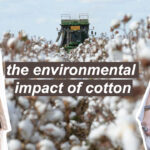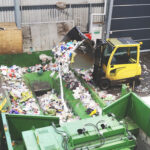
Cotton is the most utilized and profitable non-food crop in the world, with a production that employs more than 250 million people, and accounts for 7% of all labour in developing countries. Cotton is also still the most utilized textile, followed by polyester.
Globally, 35 million hectares of cotton are under cultivation. Because cotton is in so high demand, its production comes with many issues regarding sustainability and ethical production. Let’s talk about some of them here.
Also watch: The Environmental Impact of Cosmetics // what you need to know about your makeup
Water Consumption:
The production of cotton requires water, a lot of water actually. It takes about 2700 liters of water to make a single cotton t-shirt. But wait, there is more. Not only is cotton water-intensive to produce, but it is also estimated that the material is the largest user of water among all agricultural commodities due to the fact that surface and ground waters are often diverted to irrigate cotton fields. This leads to the loss of freshwater because of inefficient management and sustainability efforts. Have you ever heard of the Aral Sea? Located in Central Asia, this body of water was once the 4th largest lake in the world, but in 2020 it is basically completely vanished, 85% of the water is gone. The Indus River in Pakistan is also deeply affected by the cotton industry, as 97% of the river water is diverted into cotton production. In the United States cotton where cotton is also farmed, the groundwater levels have dropped 8 feet between 2004 and 2014 as a result of cotton’s water consumption during periods of drought.
Also watch: BIOPLASTIC (?) // everything you should know about “compostable” plastics

Pesticide Pollution:
While only 2.4% of the world’s arable land is planted with cotton, 25 percent of the world’s insecticides and 18 percent of pesticides are used to grow it; that makes cotton production is the number 1 consumer of pesticides in the world, and that has some deadly consequences. 43 million tons of pesticide-filled dust from cotton fields are blown into the air every year. The region around the Aral Sea suffers the highest rate of throat cancer in the world, as a result of inhaling the air. The rainwater in Brazil’s cotton region contained 19 different pesticides, 12 of which were common in cotton production.
Also watch: HOW IS STREAMING AFFECTING THE PLANET? // the price of being plugged in
But pesticides do not only affect air quality. Pesticide use also causes water pollution and contamination and affects both animals and people. This is something that truly makes me feel awful, the people who are exposed to the polluted air and water have much higher rates of miscarriages and malformations at birth, as well as several cancers, all because of one crop.
There is also the notion that cultivating a monocrop has severe consequences for the surrounding ecosystems, and especially so when those monocrops are protected with synthetic fertilizers.

Also watch: HOW SUSTAINABLE IS PAPER & CARDBOARD? / paper vs plastic disposables
Fabric Production:
Before cotton can become a t-shirt, a reusable shopping bag, bed sheets or anything else, it has to be made into a fabric. To do that, the cotton is processed with several dyes and chemicals. The documentary River Blue did an amazing job at showing how these chemicals are often disposed of through anonymous pipes and tunnels and straight out into oceans and rivers. A big problem with many clothing factories, and especially in fast fashion, is that the workers’ health and the environmental effects these chemicals have on the water nearby is not being prioritized. Proper water filtration and chemical waste management is expensive and often completely overlooked.

Also watch: THE IMPACT OF GLASS // what we all should know
So what about organic cotton?
Organic cotton does come with some benefits but it is easy to get lost in the greenwashing jungle. “Organic” is a word that can mean different things depending on where you live. Sometimes a product can say it’s organic without having done anything in particular to achieve that status. Therefore it is important to look for international and third-party certifications like GOTS (Global Organic Textile Standards) which actually ensure that the correct measures have been made to improve the product.
- Certified organic cotton often means that the cotton was planted in places where heavy rain usually occurs so no irrigation is needed and that way the water consumption of the cotton becomes much less.
- Organic cotton is also more sustainable in the sense that it is not grown with the heavy pesticide usage that we know from conventional cotton. Other methods to ensure cotton quality is utilized.
- It also means that the cotton is not treated with the same heavy-duty chemicals as we talked about before, rather natural dyes are used and as a result, the fabrics become safer for the workers who handle them and better for the environment.
Also watch: IS ALUMINIUM SUSTAINABLE? // what’s better cans or bottles?

How can we consume cotton in an eco-conscious way?
- Avoid single-use and disposable cotton products like cotton swaps, q-tips, makeover remover wipes, and cotton single-use tissues. Rather find reusable alternatives can that be washed and used again. The water used to clean a product is far, far less than the amount of water it takes to make new cotton products, so cherish what you have.
- Don’t buy from fast fashion. One of the main reasons why cotton is such a utilized crop is because the fast fashion industry produces 100 billion pieces of clothing every single year, while 80% of it ends up in landfill or in an incinerator, only 20% of our clothes are recycled and one of the reasons why is because fast-fashion retailers are pushing out so much clothing a quality that makes recycling impossible.
- Support organic initiatives and look for certification rather than trusting buzzwords on the packaging. We need receipts, yo!
- Do not buy or accept products you don’t need, yes I am looking at you 34th free tote bag and freebie t-shirt from my gym. The cotton tote bag is often advertised as a more sustainable alternative to the plastic bag, but that is only true if you use it every day for several years. The resources it required to produce a tote bag is significantly higher than the resources it took to make a plastic bag, so there is no point in stocking up pretty totes and buying a new one every week, get as much wear out of the ones you have as possible.
- See the value in a cotton shirt, aware of trousers, underwear, and socks, and if they break try and repair them. Instead of seeing the finished product try and look at these items as resources and what they represent and treat them with that kind of respect and care.
- Do not overconsume, this applies to fashion, home décor, fancy eco tote bags, and even GOTS certified cotton. Buy what you need and make sure to not buy more than is necessary. It is easy to think that when a product is sustainable we don’t have to be careful, but a product is only sustainable if it is used right and those 14 organic cotton shirts that you never wear are still overconsumption.
You can find all the sources in the video description.




